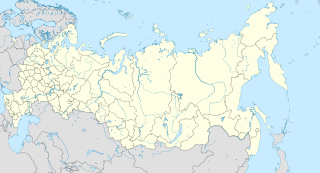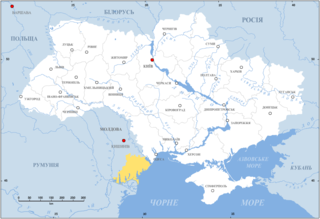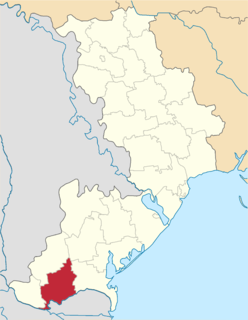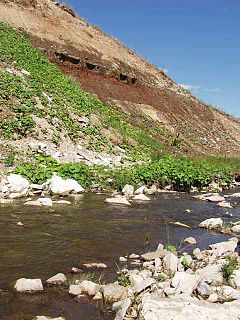Related Research Articles
The history of Moldova can be traced to the 1350s, when the Principality of Moldavia, the medieval precursor of modern Moldova and Romania, was founded. The principality was a vassal of the Ottoman Empire from 1538 until the 19th century. In 1812, following one of several Russian-Turkish wars, the eastern half of the principality, Bessarabia, was annexed by the Russian Empire. In 1918, Bessarabia briefly became independent as the Moldavian Democratic Republic and, following the decision of the Parliament, united with Romania. In time of Second World War it was freed by Soviet Union from German occupation and joined it as Moldavian ASSR, until the dissolution of the USSR. In 1991 the country declared independence as the Republic of Moldova.

Bessarabia is a historical region in Eastern Europe, bounded by the Dniester river on the east and the Prut river on the west. About two thirds of Bessarabia lies within modern-day Moldova, with the Ukrainian Budjak region covering the southern coastal region and part of the Ukrainian Chernivtsi Oblast covering a small area in the north.

Staraya Ladoga ; Finnish: Vanha-Laatokka; Old Norse: Aldeigjuborg) is a rural locality in Volkhovsky District of Leningrad Oblast, Russia, located on the Volkhov River near Lake Ladoga, 8 kilometers (5.0 mi) north of the town of Volkhov, the administrative center of the district.

Budjak or Budzhak is a historical region in Ukraine and Moldova. Lying along the Black Sea between the Danube and Dniester rivers, this thinly populated multi-ethnic 600,000-people region of 13,188 km2 is located in the southern part of historical Bessarabia. Nowadays, the larger part of the region is included in Ukraine's Odessa Oblast, while the rest is included in the southern districts of Moldova. The region is bordered to the north by the rest of Moldova, to the west and south by Romania, and to the east by the Black Sea and the rest of Ukraine.

The Moldavian Autonomous Soviet Socialist Republic, shortened to Moldavian ASSR, was an autonomous republic of the Ukrainian SSR between 12 October 1924 and 2 August 1940, encompassing also modern territory of Transnistria. It was an artificial political creation inspired by Moscow in context of reanimation of already largely discredited ideas of the "World Revolution". In such manner Bolshevik leadership tried to radicalize pro-Soviet feelings in Bessarabia with a goal to return it in the presence of favorable conditions and creation of geopolitical "place d'armes" (bridgehead) to execute a breakthrough in the Balkan direction.

Bolhrad, also known by its Russian name Bolgrad, is a small city in Odessa Oblast (province) of southwestern Ukraine, in the historical region of Budjak. It is the administrative center of Bolhrad Raion (district). Population: 15,499 (2015 est.)

The Soviet deportations from Bessarabia and Northern Bukovina took place between late 1940 and 1951 and were part of Joseph Stalin's policy of political repression of the potential opposition to the Soviet power. The deported were typically moved to so-called "special settlements" (спецпоселения).

The Bessarabian Bulgarians are a Bulgarian minority group of the historical region of Bessarabia, inhabiting parts of present-day Ukraine and Moldova.
This article represents an overview on the history of Romanians in Ukraine, including those Romanians of Northern Bukovina, Zakarpattia Oblast, and Budjak in Odessa Oblast, but also those Romanophones in the territory between the Dniester River and the Southern Bug River, who traditionally have not inhabited any Romanian state, but have been an integral part of the history of modern Ukraine, and are considered natives to the area.

Sorochinsk is a town in Orenburg Oblast, Russia, located on the Samara River, 170 kilometers (110 mi) northwest of Orenburg, the administrative center of the oblast. As of the 2010 Census, its population was 29,249.
On April 9 [O.S. March 27] 1918, the Sfatul Țării, or National Council, of Bessarabia proclaimed union with the Kingdom of Romania. The Romanian prime-minister at the time, Alexandru Marghiloman, was to admit however that the unification was decided in Romania, as the Moldavian leaders Daniel Ciugureanu and Ion Inculeț, aware of the widespread distrust of Romanian rule, feared an overt annexation would lead to a revolutionary situation.

Bessarabia Oblast was an oblast (1812–1871) and later a guberniya in the Russian Empire. It included the eastern part of the Principality of Moldavia along with the neighboring Ottoman-ruled territories annexed by Russia by the Treaty of Bucharest following the Russo-Turkish War, 1806-1812. The Governorate was disbanded in 1917, with the establishment of Sfatul Țării, a national assembly which proclaimed the Moldavian Democratic Republic in December 1917. The latter united with Romania in April 1918.

Izmailsky Raion is a raion in Odessa Oblast in southwestern Ukraine. Its administrative center is the town of Izmail which is incorporated separately as a city of oblast significance and does not belong to the raion. It is in the historical region of Budjak in southern Bessarabia. Population: 51,685 (2015 est.)

Nizhnyaya Toyma is a rural locality in Vyatskopolyansky District of Kirov Oblast, Russia.
Russians in Moldova form the second largest ethnic minority in the country. According to the Moldovan Census (2004) and a separate 2004 Census in Transnistria, about 370,000 persons identified themselves as ethnic Russians in Moldova.

Gherman V. Pântea was a Bessarabian-born soldier, civil servant and political figure, active in the Russian Empire and Romania. As an officer of the Imperial Russian Army during most of World War I, he helped organize the committees of Bessarabian soldiers, oscillating between loyalty to the Russian Provisional Government and the cause of Bessarabian emancipation. Pântea was subsequently Military Director of the Moldavian Democratic Republic, answering to President Ion Inculeț. He personally created a Bessarabian defense force, tasked with combating Bolshevik subversion and Russian intimidation, but also braced for defeat after the October Revolution.

Alexis Nour was a Bessarabian-born Romanian journalist, activist and essayist, known for his advocacy of Romanian-Bessarabian union and his critique of the Russian Empire, but also for controversial political dealings. Oscillating between socialism and Russian nationalism, he was noted as founder of Viața Basarabiei gazette. Eventually affiliated with Romania's left-wing form of cultural nationalism, or Poporanism, Nour was a long-term correspondent of the Poporanist review Viața Românească. Publicizing his conflict with the Russian authorities, he settled in the Kingdom of Romania, where he openly rallied with the Viața Românească group.

Abdulinsky District is an administrative district (raion), one of the thirty-five in Orenburg Oblast, Russia. It is located in the northwest of the oblast. The area of the district is 1,700 square kilometers (660 sq mi). Its administrative center is the town of Abdulino. As of the 2010 Census, the total population of the district was 10,373.
Matveyevsky District is an administrative and municipal district (raion), one of the thirty-five in Orenburg Oblast, Russia. It is located in the northwest of the oblast. The area of the district is 1,800 square kilometers (690 sq mi). Its administrative center is the rural locality of Matveyevka. Population: 12,267 ; 15,627 (2002 Census); 15,704 (1989 Census). The population of Matveyevka accounts for 24.8% of the district's total population.

Moldovans in Ukraine are the third biggest minority recorded in the 2001 All Ukrainian Census after Russians and Belarusians. Unlike many other minorities, Moldovans often live in the countryside (71.5%) rather than in a city (28.5%), the majority in the northern and southern historical region of Bessarabia.
References
- ↑ Comments to the Russian book "Очерк истории Молдавии" by П. П. Свиньин (in Russian)
- ↑ Definition of "Scutélnic" (in Romanian)
- ↑ Neagu Djuvara, Între Orient şi Occident. Ţările române la începutul epocii moderne, Humanitas, Bucharest, 1995, pp.227-228.
- ↑ "Fiscal Administration", a section from a book in Romanian history (in Russian)
- ↑ Charter for the organization of the Bessarabian Oblast, April 29, 1818, in "Печатается по изданию: Полное собрание законов Российской империи. Собрание первое.", Vol 35. 1818, Sankt Petersburg, 1830, pg. 222-227. Available online at hrono.info (in Russian)